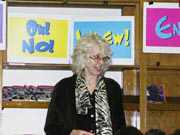"How many students have gotten something like this back?" asked children’s book author Della Rowland to students at Public School No. 5. Rowland was showing the students a slide of a writing sample she had given to her editor that now had red marks and corrections all over it.
"This is what my editor gave to me," said Rowland after everyone in the room said that they had had similar marks done on their papers. "This is what helps you to become a better writer. It is not to tell you never to write again. There is always room to improve."
Rowland, most famous for her Clue, Jr. Mystery Series books for children, visited the West New York elementary school last week to perform writing workshops with all of the classes. Rowland visited the school on Dec. 6 and 7.
Rowland, who now lives in Bergen County, visits many schools throughout the year.
"Writing is a really lonely job," said Rowland afterwards, about why she likes to work with children. "You just sit in your room with your computer and the characters you make up in your head."
"I get something back," added Rowland. "I get renewed. I am blown away by the kids’ imaginations. It makes me want to write again."
Rowland’s was invited to Public School No. 5 by the school’s management team. The management team is comprised of students, faculty, administrators and parents.
"The school management team has been finding ways to bring positive role models in for the children," said Caryn Biancosino, a Basic Skills teacher at Public School No. 5 and a member of the management team. "We wanted the children to develop an interest in reading and writing."
According to Principal Al Lopez, the school has been focusing a lot on reading and writing. Public School No. 5 was named the first NBA Reading Center earlier this year.
"We have been looking at the needs of our students and coming up with programs that would benefit our students," said Eileen Calderone, Public School No. 5’s school facilitator.
Rowland began her career as a magazine and book editor before turning to writing.
Getting an idea
Sometimes, just figuring out what to write about can be the hardest part about writing. Rowland, who said she gets her ideas from just about anything, showed the students at Public School No. 5 some slides of things that gave her ideas. She showed pictures of her family, a pet store and the zoo.
"Ideas come quick and come brilliantly," said Rowland, telling the students that once they get an idea they should write it down immediately.
Rowland explained how one idea came to her after seeing a group of people feeding a giraffe at the zoo. Rowland performed some research on giraffes and found that they don’t make any noise. This little known fact about giraffes was used as a clue in The Case of the Zoo Clue, one of the books in Rowland’s Clue, Jr. Series.
However, Rowland also told the students that she too gets writer’s block from time to time. During these times, Rowland does something else, like taking a walk or reading someone else’s book.
The five W’s
It is not every day that students get to solve a mystery in their own school. However, after Rowland discovered that the school has had a missing case of milk in its delivery both days she was visiting, the students were able to work out their own solution.
Usually, Rowland said that she begins her workshops by giving the class a character and a setting that they may know. Rowland uses an android – part human/part robot – character and a school as the setting and places the story in the future. Then the kids get to decide how far in the future, what school it is and what happens to him.
"I give them something they know and then let them create it," said Rowland.
Rowland began the writing exercise by creating characters, a setting and a plot. Rowland explained how the students should use the five W’s (who, what, when, where and why), and the "how" questions to create these story elements.
"’Why’ is a writer’s best friend," said Rowland explaining that the question "why?" adds the needed details to your story. Rowland used the who question to create her characters, the when and where questions to create the setting and the what and why questions to create the plot.
The fourth grade students were the first class to brainstorm ideas to solve the mystery taking place at their own school.
After a brief discussion of what could have happened to the milk, the class decided on fourth grade student Kristallyn Moran’s idea that the case was misplaced somewhere in the school.
"When writing a mystery story," explained Rowland, "you have to have your solution already. Then you can go back and leave some clues."
Rowland encouraged the students to write on their own and left a list of children’s magazines that publish essays and poetry written by kids.
"You are not going to be a writer by thinking," said Rowland. "You become a writer by writing."
